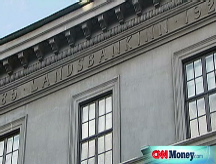Dollar sinks as rate-cut expectations grow
Dollar falls from 14-month high against euro, as talk of Fed action on interest rates increases.
NEW YORK (CNNMoney.com) -- The dollar sank against most foreign currencies Tuesday, as the still-frozen credit markets led a majority of investors to believe the Federal Reserve will step in with rate cuts, in addition to buying loans crucial to business.
In a speech before the National Association of Business Economics in Washington on Tuesday, Fed Chairman Ben Bernanke signaled that the U.S. central bank may be getting ready to cut interest rates. He said the Fed will consider the appropriateness of its monetary policy given the state of the economy.
The Fed announced earlier Tuesday it would take action to backstop the commercial paper market, by purchasing companies' short-term debt. That sparked more speculation that the bank needs to cut rates in its meeting Oct. 29 - or even before that in emergency action.
On the Chicago Board of Trade, futures indicated a 48% chance that the Fed will lower its rate to 1.5% from 2%, and the futures showed a 58% chance that the rate will be cut to 1.25%.
The U.S. central bank could choose to lower its key funds rate, which is a rate banks charge other banks to borrow money, in an attempt to further encourage lending and thereby return the normal flow of credit to businesses.
But rate cuts are also inflationary, worrying dollar investors that their investments will devalue over time as the Treasury prints more money.
Euro: Due partly to these concerns, the euro traded at $1.3615 as of 4 p.m. ET. That's up from $1.3498 on Monday. At one point on Monday, the euro hit $1.3443, the lowest level the currency has seen since Aug. 20, 2007.
But while investors seem to expect the United States to cut rates, they aren't quite holding their collective breath yet for Europe to do the same.
"The European Central Bank hasn't sent a clear signal that it will decrease rates anytime soon," said Rivera, currency strategist with Forex Capital Markets. "The much higher expectations that the Fed will cut rates are weighing on the dollar."
British rate cut: Speculation is brewing, however, about a possible rate cut in the U.K. when the Bank of England meets on Thursday, which held the British pound back a bit from achieving the same gains that the euro saw.
At 4 p.m. ET, the British pound bought $1.7483, up from Monday's $1.7438 level. At one point Monday, the U.K. currency sank as low as $1.7335, the lowest point the pound has seen since March 13, 2006.
Yen: The dollar fell 0.6% against the yen to ¥101.31 after a historic collapse the day before. The dollar fell as low as 4.8%, or ¥100.23 during Monday trading - the biggest one-day drop ever. The dollar recovered a bit from hitting a 6-month low, ending the day at ¥101.82.
The yen was actually down as much as 1% earlier in the day when Australia's central bank slashed rates early Tuesday and ECB President Jean-Claude Trichet said the bank would continue to provide liquidity to financial institutions for as long as needed.
The yen typically increases when investors show aversion to risk.
But the Fed's plans may be a long-term positive for the dollar. With global economies struggling, the United States may in fact have the best chance to recover first.
"It's a coin flip," said Rivera. "If they have to take measures like this, it may heighten concerns, but the whole concerted effort can be seen as a bottom, and we may start seeing buyers come into the market with confidence that the credit crisis is almost over."
In fact, the euro and pound had been much higher against the dollar before Bernanke's speech. One analyst says some investors were encouraged that the rate cuts will eventually help the economy.
"There is some reassurance coming back into the marketplace," said Garreth Sylvester, senior currency strategist with HFIX. "Bernanke said he was confident in the measures taken to stifle current climate, and suggested the Treasury's [financial rescue] plan may be enough." ![]()




